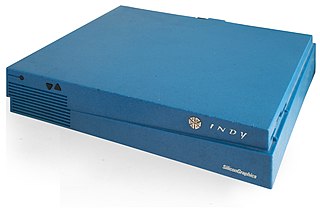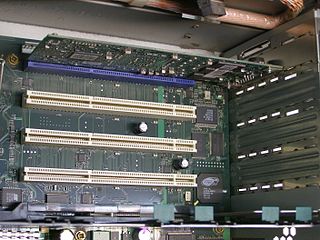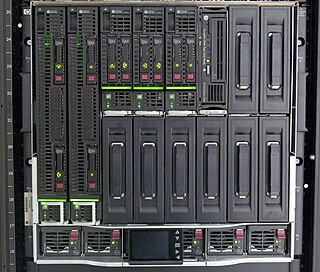
In computing, an expansion card is a printed circuit board that can be inserted into an electrical connector, or expansion slot on a computer's motherboard to add functionality to a computer system. Sometimes the design of the computer's case and motherboard involves placing most of these slots onto a separate, removable card. Typically such cards are referred to as a riser card in part because they project upward from the board and allow expansion cards to be placed above and parallel to the motherboard.

PCI Express, officially abbreviated as PCIe or PCI-e, is a high-speed serial computer expansion bus standard, designed to replace the older PCI, PCI-X and AGP bus standards. It is the common motherboard interface for personal computers' graphics cards, sound cards, hard disk drive host adapters, SSDs, Wi-Fi and Ethernet hardware connections. PCIe has numerous improvements over the older standards, including higher maximum system bus throughput, lower I/O pin count and smaller physical footprint, better performance scaling for bus devices, a more detailed error detection and reporting mechanism, and native hot-swap functionality. More recent revisions of the PCIe standard provide hardware support for I/O virtualization.

VMEbus is a computer bus standard physically based on Eurocard sizes.
Apollo/Domain is a series of workstations that were developed and produced by Apollo Computer from c. 1980 to 1989. The machines were built around the Motorola 68k series of processors, except for the DN10000, which has from one to four of Apollo's RISC processors, named PRISM.

A network interface controller is a computer hardware component that connects a computer to a computer network.

Quadrics was a supercomputer company formed in 1996 as a joint venture between Alenia Spazio and the technical team from Meiko Scientific. They produced hardware and software for clustering commodity computer systems into massively parallel systems. Their highpoint was in June 2003 when six out of the ten fastest supercomputers in the world were based on Quadrics' interconnect. They officially closed on June 29, 2009.

The DECstation was a brand of computers used by DEC, and refers to three distinct lines of computer systems—the first released in 1978 as a word processing system, and the latter two both released in 1989. These comprised a range of computer workstations based on the MIPS architecture and a range of PC compatibles. The MIPS-based workstations ran ULTRIX, a DEC-proprietary version of UNIX, and early releases of OSF/1.

The Octane series of IRIX workstations was developed and sold by SGI in the 1990s and 2000s. Octane and Octane2 are two-way multiprocessing-capable workstations, originally based on the MIPS Technologies R10000 microprocessor. Newer Octanes are based on the R12000 and R14000. The Octane2 has four improvements: a revised power supply, system board, and Xbow ASIC. The Octane2 has VPro graphics and supports all the VPro cards. Later revisions of the Octane include some of the improvements introduced in the Octane2. The codenames for the Octane and Octane2 are "Racer" and "Speedracer" respectively.

The Indy, code-named "Guinness", is a low-end multimedia workstation introduced on July 12, 1993 by Silicon Graphics Incorporated (SGI). SGI developed, manufactured, and marketed Indy as the lowest end of its product line, for computer-aided design (CAD), desktop publishing, and multimedia markets. It competed with Intel x86 computers, and with Windows and Macintosh, including using their files and running their applications via software emulation. It is the first computer to come standard with a video camera, called IndyCam.

PCI-X, short for Peripheral Component Interconnect eXtended, is a computer bus and expansion card standard that enhances the 32-bit PCI local bus for higher bandwidth demanded mostly by servers and workstations. It uses a modified protocol to support higher clock speeds, but is otherwise similar in electrical implementation. PCI-X 2.0 added speeds up to 533 MHz, with a reduction in electrical signal levels.

HP 9000 is a line of workstation and server computer systems produced by the Hewlett-Packard (HP) Company. The native operating system for almost all HP 9000 systems is HP-UX, which is based on UNIX System V.

SPARCstation 5 or SS5 is a workstation introduced by Sun Microsystems in March 1994. It is based on the sun4m architecture, and is enclosed in a pizza-box chassis. Sun also offered a SPARCserver 5 without a framebuffer. A simplified, cheaper version of the SS5 was released in February 1995 as the SPARCstation 4. Sun also marketed these same machines under the "Netra" brand, without framebuffers or keyboards and preconfigured with all the requisite software to be used as web servers. An estimated 400,000+ SPARCstation 5s were sold.

Sun-1 was the first generation of UNIX computer workstations and servers produced by Sun Microsystems, launched in May 1982. These were based on a CPU board designed by Andy Bechtolsheim while he was a graduate student at Stanford University and funded by DARPA. The Sun-1 systems ran SunOS 0.9, a port of UniSoft's UniPlus V7 port of Seventh Edition UNIX to the Motorola 68000 microprocessor, with no window system. Affixed to the case of early Sun-1 workstations and servers is a red bas relief emblem with the word SUN spelled using only symbols shaped like the letter U. This is the original Sun logo, rather than the more familiar purple diamond shape used later.

DEC 3000 AXP was the name given to a series of computer workstations and servers, produced from 1992 to around 1995 by Digital Equipment Corporation. The DEC 3000 AXP series formed part of the first generation of computer systems based on the 64-bit Alpha AXP architecture. Supported operating systems for the DEC 3000 AXP series were DEC OSF/1 AXP and OpenVMS AXP.
RM Nimbus was a range of personal computers from British company Research Machines sold from 1985 until the early 1990s, after which the designation Nimbus was discontinued. The first of these computers, the RM Nimbus PC-186, was not IBM PC compatible, but its successors the PC-286 and PC-386 were. RM computers were predominantly sold to schools and colleges in the United Kingdom for use as LAN workstations in classrooms.
HP X-Terminals are a line of X terminals from Hewlett Packard introduced in the early- to mid-1990s, including the 700/X and 700/RX, Envizex and Entria, and the Envizex II and Entria II. They were often sold alongside PA-RISC-based HP 9000 Unix systems. The primary use case was connecting several graphical consoles to a single server or workstation to allow multiple users access the same (expensive) processing system from terminal systems. These X-Terminals all allowed high-resolution, color-graphics access to the main server from which they downloaded their operating system and necessary program files. All models featured limited expandability, in most cases additional I/O options for peripherals and memory for more programs or local storage. HP did not use its own PA-RISC platform for these systems, the first design used an Intel CISC processor, while all later systems used RISC platforms, first Intel i960 and later the popular MIPS.
The ZEGO is a rackmount server platform built by Sony, targeted for the video post-production and broadcast markets. The platform is based on Sony's PlayStation 3 as it features both the Cell Processor as well as the RSX 'Reality Synthesizer'. It is aimed to greatly speed up postproduction work, 3D rendering and video processing. In some respects it is rather similar to IBM's QS20/21/22 blades, although Sony seems to target the DCC markets rather than scientific like IBM, which can be seen by the inclusion of the RSX graphics processor in the ZEGO platform.

BladeSystem is a line of blade server machines from Hewlett Packard Enterprise that was introduced in June 2006.
SwitchBlade is the registered name of a family of layer 2 and layer 3 chassis switches developed by Allied Telesis. Current models include the SwitchBlade x908 GEN2 and the SwitchBlade x8100 layer 3 chassis switches. The first model was the SwitchBlade 4000-layer 3 core chassis, which ran the earlier AlliedWare operating system.












